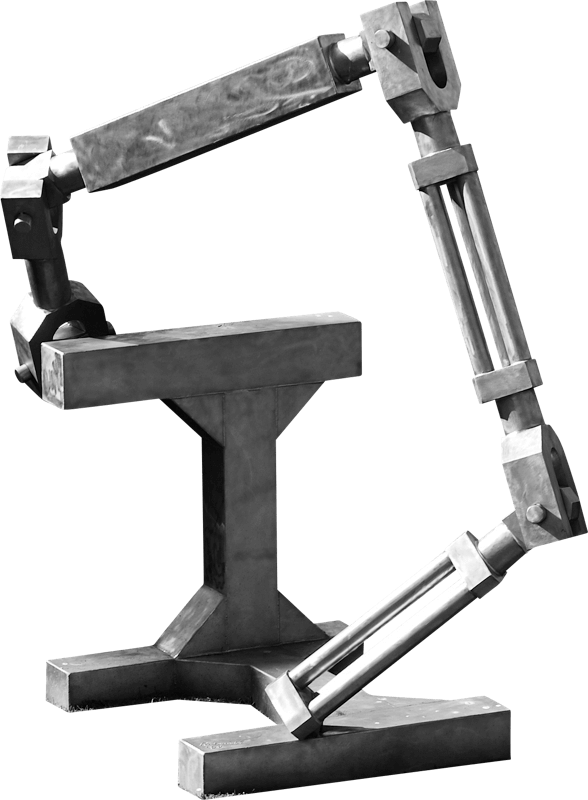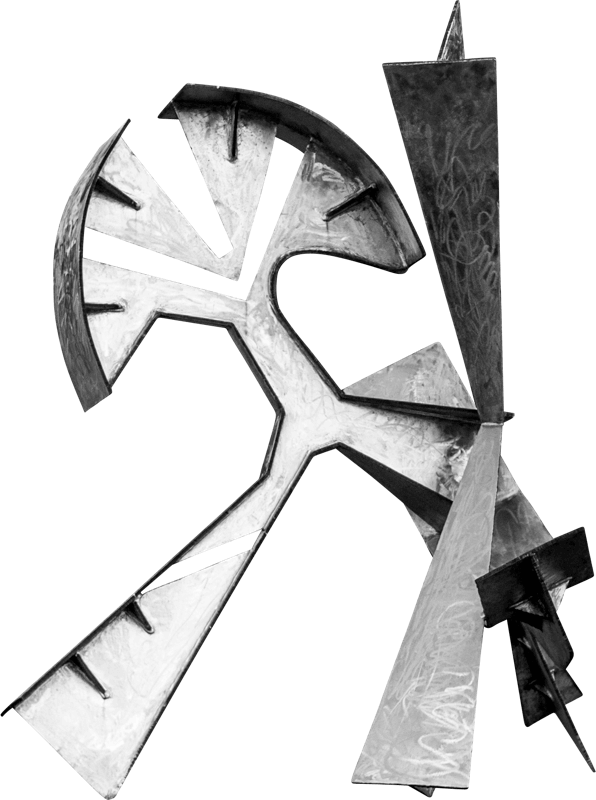Early Works
Soon after completing graduate school in the US and returning to Canada, Rubinoff was represented by art dealer Helen Mazelow. These works were originally part of a one-man show in 1971 at the Ontario Science Centre. They explore the poetry of contrast between angular and fluid forms, and between vectors of motion. In the 1970s Rubinoff started to develop a language of counterpoint in ‘positive’ plastic form and ‘negative’ space.
Early Work 1
Jeffrey Rubinoff
1971, A 242 Cor-ten steel – Welded plate, H 4ft W 2.5ft L 4ft
This work explores the play of angular planes of the tetrahedron, a shape not commonly used in sculpture at the time. It conveys a sense of motion through molten eruptions, which provide tension with the otherwise geometric forms.
This work explores the play of angular planes of the tetrahedron, a shape not commonly used in sculpture at the time. It conveys a sense of motion through molten eruptions, which provide tension with the otherwise geometric forms.
Early Work 2
Jeffrey Rubinoff
1971, A 242 Cor-ten steel – Welded plate/tube/rod, H 3ft W 3ft L 4ft
Early Work 2
Jeffrey Rubinoff
1971, A 242 Cor-ten steel – Welded plate/tube/rod, H 3ft W 3ft L 4ft
The three-faced tetrahedron is echoed in the tripod base of this work, as the composition rises off the ground. The tetrahedron is placed at the terminus of a trio of parallel vectors indicating a direction of motion.
Early Work 3
Jeffrey Rubinoff
1971, A 242 Cor-ten steel – Welded plate/tube, H 3ft W 4ft L 3.5ft
Rubinoff stated that a good sculpture should have infinite picture planes seen in 360 degrees. This piece introduces the contrapuntal mirroring of various formal elements: two tetrahedrons along the vertical axis, as well as four 120-degree angle forms along both vertical and horizontal axes. This visual counterpoint is echoed in the almost symmetrical molten forms that flow down and splash up off the ground. This organic form elegantly disrupts the geometric elements by incorporating some of their strict symmetry.
Rubinoff stated that a good sculpture should have infinite picture planes seen in 360 degrees. This piece introduces the contrapuntal mirroring of various formal elements: two tetrahedral along the vertical axis, as well as four 120-degree angle forms along both vertical and horizontal axes. This visual counterpoint is echoed in the almost symmetrical molten forms that flow down and splash up off the ground. This organic form elegantly disrupts the geometric elements by incorporating some of their strict symmetry.
Early Work 4
Jeffrey Rubinoff
1971, A 242 Cor-ten steel – Welded plate/tube/rod, H 6ft W 5ft L 6ft
Early Work 4
Jeffrey Rubinoff
1971, A 242 Cor-ten steel – Welded plate/tube/rod, H 6ft W 5ft L 6ft
The piece returns to the concerns of Early Work 2, this time with an emphasis on contrasting motion between the vector of the tetrahedron, and the molten planar element that cascades to the ground.
Early Work 5
Jeffrey Rubinoff
1971, A 242 Cor-ten steel – Welded plate/tube, H 4ft W 2.5ft L 4ft
This simple yet powerful crystallization of the tensions between the severe and almost self-contained hovering tetrahedron, and an uncontained eruption of steel which flows, and seems to splash, to the ground.
This simple yet powerful crystallization of the tensions between the severe and almost self-contained hovering tetrahedron, and an uncontained eruption of steel which flows, and seems to splash, to the ground.
Early Work 6
Jeffrey Rubinoff
1975, A 242 Cor-ten steel – Welded plate, H 4ft W 2.5ft L 6ft
Early Work 6
Jeffrey Rubinoff
1975, A 242 Cor-ten steel – Welded plate, H 4ft W 2.5ft L 6ft
Returning to the I-beam and the rectangular cubic forms of Early Work 4, the apparent heaviness of the cross-shaped cuboid foot pulls down and away from the I-beam superstructure. This creates a sense of tugging through the contrasting visual weights of the form elements.

















